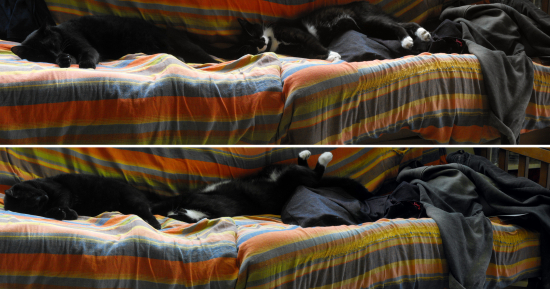
archives for 07/2009
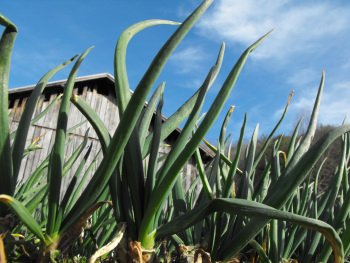 I asked Strider to pick out our Egyptian
Onion giveaway winner. I spread everyone's names out on the
sofa, and he went straight for Mandi's name and started to eat her
up. Congratulations, Mandi (as long as Strider doesn't get
you!) Please drop me an email
with your mailing address and your Egyptian onions will be on their way
to you shortly.
I asked Strider to pick out our Egyptian
Onion giveaway winner. I spread everyone's names out on the
sofa, and he went straight for Mandi's name and started to eat her
up. Congratulations, Mandi (as long as Strider doesn't get
you!) Please drop me an email
with your mailing address and your Egyptian onions will be on their way
to you shortly.
To everyone who didn't win --- stay tuned. I may do another
Egyptian Onion giveaway soon as long as local friends don't clean me
out. Thanks for playing!

 Tuesday afternoon, I played
hooky and went to the Scott
County Lavender Farm with my mom and some friends. The farm
seems like a great ecotourism business on the surface --- attract folks
to the beauty and scent of lavender, then sell them all kinds of
related products. Unfortunately, the farm was closed and going to
weeds.
Tuesday afternoon, I played
hooky and went to the Scott
County Lavender Farm with my mom and some friends. The farm
seems like a great ecotourism business on the surface --- attract folks
to the beauty and scent of lavender, then sell them all kinds of
related products. Unfortunately, the farm was closed and going to
weeds.
Our visit just confirmed a feeling I've had for quite a while --- the
best homestead businesses aren't physically farm-related. We've
given various options a shot, from a little CSA to selling native
wildflowers. But when I do the math, I always discover that on a
small, homestead
microbusiness scale, these ventures barely pay minimum wage.
Even before our current recession, people in our area complained about
the lack of good jobs, a constant problem in rural areas. But I
feel strongly that in our current world, anyone with imagination and
gumption can make a living through learning a useful skill and taking
advantage of the internet. Then you can save your farming for
yourself, putting all of that love and time into your vegetables so
that it flows right back into yourself.
Several people have asked for advice on starting a homestead
microbusiness, and I've been starting to compile a lot of pointers
about what we've learned with Mark's chicken waterer
invention. Assuming I don't play hooky too many more times, I
hope to have an ebook out for folks to read in a couple of
months. Stay tuned!
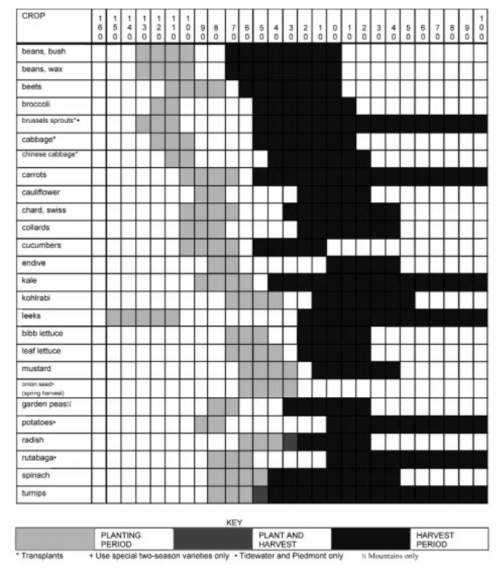 On
Monday, I admonished you that August is too late to start planning your
fall garden. Instead, you want to start planting some fall crops
now and continue through September for others.
On
Monday, I admonished you that August is too late to start planning your
fall garden. Instead, you want to start planting some fall crops
now and continue through September for others.
Last year, I posted an
extensive explanation about when to plant
vegetables in your fall garden.
The chart in that post (a larger version of the one to the right) makes
it easy to plug in your last frost date
and decide when seeds need to go in the ground. For example, here
in zone 6 we'll be planting parsnips, carrots, and broccoli this week,
among other things.
But what do you do if
your favorite vegetable isn't on that chart? Take out your seed
packet and you'll notice that it usually contains a "days to maturity"
number. Count back that many days from your average first frost
date, add two weeks (since plants grow slower in the fall) and you have
your planting date.
| This post is part of our Planning Your Fall Garden lunchtime series.
Read all of the entries: |

We've just made an improvement to our archive section of
the website. Now you can easily read all previous entries back to back
until you're caught up and feeling the full force of the Walden Effect.
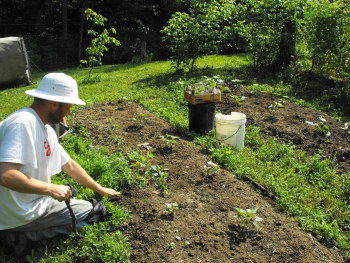 Remember when I planted
broccoli, swiss chard, and sweet potatoes in gaps in the garden?
Wednesday, we finally got around to checking up on them, pulling out
dying peas and weeds. I was surprised to discover that our young
plants were all growing beautifully!
Remember when I planted
broccoli, swiss chard, and sweet potatoes in gaps in the garden?
Wednesday, we finally got around to checking up on them, pulling out
dying peas and weeds. I was surprised to discover that our young
plants were all growing beautifully!
Of course, there were some gaps where the peas had been. So we
filled in the gaps...again. Still, this has been a very effective
rotation --- I'll have to remember it for next year.
 Now
you know what
you're going to plant and when
to plant it, but there are
still a few tricks to having a successful fall garden. The
biggest problem with planting fall vegetables is that you're putting
seeds of cool-weather crops in the ground during the heat of
summer. In many cases, the soil may be too dry for the seeds to
germinate.
Now
you know what
you're going to plant and when
to plant it, but there are
still a few tricks to having a successful fall garden. The
biggest problem with planting fall vegetables is that you're putting
seeds of cool-weather crops in the ground during the heat of
summer. In many cases, the soil may be too dry for the seeds to
germinate.
Here are my top tips for
good summer germination:
- If your soil is really
dry, water the area a day or two before planting. Better yet,
plan your planting for the day before a forecast storm.
- Plant your seeds deeper than you would have in the spring --- often, there's moisture about half an inch below the surface.
- Plant three to five
seeds in each location rather than just one. I did this with the
broccoli seeds I planted a couple of weeks ago and only had one seed
germinate in each spot. If too many seeds come up, you can always
weed down to one plant per location, or transplant to fill in gaps.
- Keep an eye on your tender seedlings for the first month or so, making sure they get an inch of water per week.
| This post is part of our Planning Your Fall Garden lunchtime series.
Read all of the entries: |
 The deer have stayed away from the garden
since the nightly
banging has begun.
The deer have stayed away from the garden
since the nightly
banging has begun.
I discovered that making a curve out of the tin at the bottom helps it
roll off the stick and prevents a situation where it gets stuck.
Adding a couple of timers was Anna's good idea.
Now we don't have to worry about forgetting to switch the things on
before bedtime.

One of the major benefits of gardening organically is the
wildlife. Our garden is so full of life that sometimes I have to
literally watch my step to make sure that I don't tread on a
toad. During our lunch breaks, we watch hummingbirds fight over
the bee balm, and gnatcatchers, buntings, and bluebirds hunt bugs among
the vegetables. Then there are the butterflies, dozens of species
with colors spanning the rainbow. Without poisons around, the
forest ecosystem creeps right into our yard.
 You'll
want to keep crop rotation in mind as you plant your fall garden.
This can be a bit tricky since many of your fall vegetables are in very
popular families:
You'll
want to keep crop rotation in mind as you plant your fall garden.
This can be a bit tricky since many of your fall vegetables are in very
popular families:
- Crucifers: broccoli, brussel sprouts, cabbage, cauliflower, collards, kale, kohlrabi
- Legumes: beans, peas
- Umbellifers: carrots, parsnips
- Nightshades: tomatoes, potatoes, eggplant
So, don't plant your
peas after your summer beans, your kale after your
spring cabbage. Instead, plant crucifers after beans, fall peas
after your spring potatoes.
Good luck with your fall
garden! If you've got any additional
pointers to share, I'd love to hear them --- I'm still working on
perfecting my fall garden.
| This post is part of our Planning Your Fall Garden lunchtime series.
Read all of the entries: |
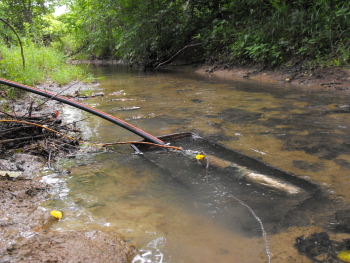 The rain has been good to us lately, but this
week it came up a little short.
The rain has been good to us lately, but this
week it came up a little short.
We had to make a small change to the creek
pumping system by adding a separate line from the pump.
This provides a more direct path to the sprinklers and has increased
the pressure by a noticeable degree.
The picture shows one of those large plastic storage units at the
bottom of the creek that provides a nice place for the pump to rest. The intake is towards the middle, so it
helps to prop the hose end up on a brick.
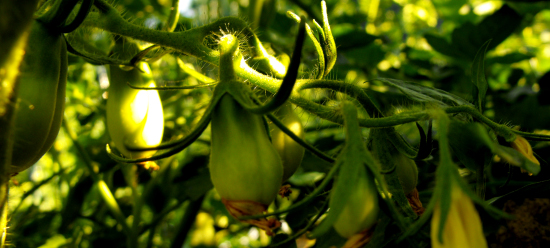
Did you buy your tomato plants from Wal-mart, K-mart, Home Depot, or
Lowes? Or even from a local nursery which doesn't grow their own
plants and instead buys them from Bonnie? Across the
eastern U.S., these stores have
pulled all tomato plants from their shelves due to a late blight
epidemic. It won't hurt you, but your plants will go kaput.
Some people even speculate that commercial growers might be
affected. That would mean few fresh tomatoes and potatoes in the
grocery stores this summer. To read about the symptoms of late
blight and more, visit
this Boston Globe article.
Of course, if you grow your own heirloom tomatoes from seed every year,
like we do, you're probably okay. Still, if your neighbors'
plants are infected, yours might be too. If you see symptoms,
you're best off yanking the plants out and burning them or putting them
somewhere far from the compost pile.
 In
the United States, the dog days of summer traditionally last from July
3 to August 11. These are supposed to be the hottest and driest
days of the year "when the seas boiled, wine turned sour, dogs
grew mad, and all creatures became languid."
In
the United States, the dog days of summer traditionally last from July
3 to August 11. These are supposed to be the hottest and driest
days of the year "when the seas boiled, wine turned sour, dogs
grew mad, and all creatures became languid."
This year, the dog days
entered with a sniffle. Cloudy skies all week have meant
blissfully cool weather, but I did hear the first dog day cicadas begin
their summer chorus. As Mark mentioned, we started to irrigate
Friday, and yesterday I had to lower our pump slightly in the well
since the groundwater had dropped.
The ancient Greeks
sacrificed a brown dog at the beginning of the dog days to plead for
cooler weather, but there's no need to worry --- Lucy is safe with us.
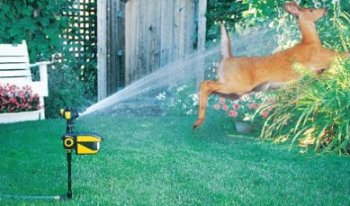 For around 60 bucks you can get a device that
combines motion detector technology and sprinklers in a way that might
work for some folks with a deer problem in their yard or garden.
For around 60 bucks you can get a device that
combines motion detector technology and sprinklers in a way that might
work for some folks with a deer problem in their yard or garden.
The CR0101
motion activated sprinkler seems like it would keep a wide array of
varmints from your precious plants, but like with any new product the
knowing is in the testing and proving that it works under real world
conditions.
This might also be the perfect and humane way of keeping
small children from entering your yard to retrieve their ball or
Frisbee.
| We finally solved the deer in
the garden problem, and the solution was so elegant we gave it a new
website. Check out our deer
deterrent website for free plans! |
 Our
bees have been in a bit of a honey
flow lull, so I was
surprised to see serious activity around the hives Sunday despite
drippy weather. A quick jaunt through the woods, though, turned
up the culprit --- Sourwood. Tiny white bells scattered on the
forest floor were the only indicator that the trees were in bloom.
Our
bees have been in a bit of a honey
flow lull, so I was
surprised to see serious activity around the hives Sunday despite
drippy weather. A quick jaunt through the woods, though, turned
up the culprit --- Sourwood. Tiny white bells scattered on the
forest floor were the only indicator that the trees were in bloom.
We don't plan to harvest
any honey this year, but if we did it might be worth trying to taste
some sourwood honey. Slow
Food USA has an
entire page about the honey, including this tantilizing quote:
Most honey is made
by bees. But sourwood is made by bees and angels.
The page also
answers a question I've always wondered about --- how can beekeepers
sell you "clover honey" or "sourwood honey" when bees are constantly
checking out alternative food sources? Honestly, I can't see
myself ever jumping through the hoops necessary to get pure sourwood
honey, but you never know....
 When
times get tough, people get chickens. You've probably heard the
same reports I have about new zoning regulations allowing chickens in
cities and about the numbers of backyard chicken keepers
skyrocketing. If our economic system crashes, at least we
chicken-keepers can subsist on eggs and an occasional roast fowl.
When
times get tough, people get chickens. You've probably heard the
same reports I have about new zoning regulations allowing chickens in
cities and about the numbers of backyard chicken keepers
skyrocketing. If our economic system crashes, at least we
chicken-keepers can subsist on eggs and an occasional roast fowl.
On the other hand, Slate
suggests that the surge in urban chicken-keeping is a bogus trend,
invented by
journalists who needed to fill some space in their newspapers.
The article made a good point that all of the evidence for the trend
appears
to be anecdotal rather than based on hard data.
Whether the trend is
real or not, we like chickens and think you will
to. So this lunchtime series is a rundown of a few
chicken-related topics near and dear to our hearts. We won't try
to reinvent the wheel and tell you all of the chicken-keeping basics,
but we will mention some of the fields we're most interested in at the
moment.
| This post is part of our Chicken Trivia lunchtime series.
Read all of the entries: |

This week's honey bee inspection revealed plenty of stored pollen and
healthy activity. It might take a few days to notice any increase in production related to the new sourwood
in bloom.
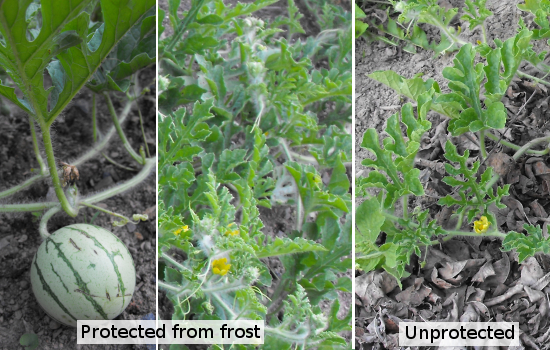
Six weeks ago, we had a late
frost and I covered everything I could with row covers.
Unfortunately, I only had enough fabric to go over one of my two
watermelon beds. At first, there didn't seem to be a big
difference between the lightly nipped bed and the protected bed, but
now the beds couldn't be more different. The unprotected bed is
only about a third covered with vines which are barely starting to
bloom. In stark contrast, the vines on the protected bed have
filled up all of their space and are heading out into the aisle...and
look at the cute little watermelons!
Next year, I'll have a better idea of which plants are top priorities
to protect from late, light frosts. For example, the unprotected
canteloupes are still sitting there doing nothing, while the
unprotected cucumbers, butternuts, and beans bounced right back as if
they were never touched. The nipped okra bed was significantly
behind its protected counterpart until three weeks ago when the deer
browsed the previously covered bed --- now both deer- and frost-nipped
beds are neck-and-neck and getting ready to bloom. Live and learn!
We can talk your ear off
about chicken tractors. In fact, we already have written at
length about the importance of chicken tractors in
the garden permaculture system. We're still working
on building the best possible tractor, though.
Of course, you can shell
out hundreds of dollars and get a ready-made
tractor, but Mark has had great luck with making our own for under $20
apiece. You can see several posts about his most recent tractor
construction project on our chickens page. But I thought I'd sum
up our findings here:
- Ignore people who say you should
add wheels to your tractor. Wheels make the tractor hard
to maneuver around your garden and are a general pain.
Make multiple doors on your tractor. Our best tractor currently has two, but I'd like it to have three --- a door in the back of the nest box for easy egg-stealing, a door on the top of the tractor so that the hens don't mob you when you drop in scraps, and a big door which allows a whole human to get in for tractor repair and lets the hens get out easily if you want them to free range.
- Make your tractor as light as possible. As the chief tractor-dragger, I have to say that pulling even our lightest tractor uphill on wet grass often ends up with me on my butt. Lighter next time, please, Mark!
Of course, you need to
add in all of the usual components --- a
perch as well as a spot for chickens to get out of the sun and
rain. Otherwise, it's pretty hard to go wrong with tractor
construction. Give it a shot --- surely you can build something
serviceable for less than a few hundred bucks!
| This post is part of our Chicken Trivia lunchtime series.
Read all of the entries: |
We invented our homemade chicken
waterer specifically for tractors. Check it out to prevent
spilling of water on uneven terrain.
 I installed a small piece of foam
pipe insulation to the shoulder strap of the MintCraft garden sprayer
for some added comfort, and now I'm wondering what took me so long to
wise up to this simple solution.
I installed a small piece of foam
pipe insulation to the shoulder strap of the MintCraft garden sprayer
for some added comfort, and now I'm wondering what took me so long to
wise up to this simple solution.
It makes hauling a full tank feel like a walk in the park.
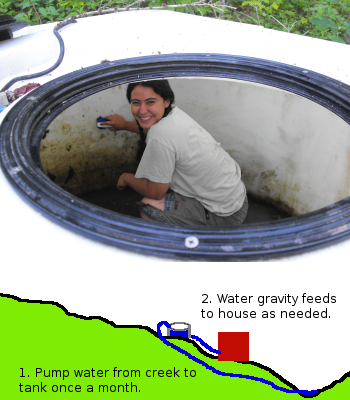 I jumped in the thousand gallon tank yesterday
morning to give it a good scrubbing, the only maintenance it has
received in months.
I jumped in the thousand gallon tank yesterday
morning to give it a good scrubbing, the only maintenance it has
received in months.
We get our drinking water from a well, but we use the creek for most of
our other water needs. Most folks who don't connect to city water
install a pressure tank, but we've found that a gravity system is
simpler and requires very little electricity.
When the tank gets low every month or two, we turn on the pump
for a few hours and top the water off. After that, gravity pushes
the water to the house to fill our sink, bathtub, washing machine, and chicken waterers.
We started out with a little 50 gallon tank on a tower by the house,
but we used up the water awfully quickly and were disappointed by the
pressure. A thousand gallon tank slightly uphill gives us much
better water pressure, approximately equal to what you'd get from city
water.
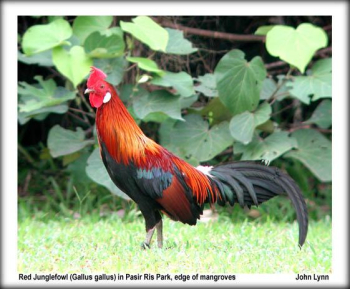 As
we start thinking outside the box when it comes to chicken care, it
helps to look at what chickens really are. Most folks believe
that chickens were domesticated from the Red Jungle Fowl which
currently lives in southeast Asia.
As
we start thinking outside the box when it comes to chicken care, it
helps to look at what chickens really are. Most folks believe
that chickens were domesticated from the Red Jungle Fowl which
currently lives in southeast Asia.
Red Jungle Fowl roosters look just like Rhode Island Reds to my
untrained eye but the hen is far less conspicuous. They act a lot
like domesticated chickens too, dust-bathing, crowing, and so
forth. One point of interest is that these are not birds of open
meadows --- Red Jungle Fowl seem to prefer bamboo forests for their
territories. That could explain why shade is such an essential
ingredient in a chicken yard on a hot summer day.
| This post is part of our Chicken Trivia lunchtime series.
Read all of the entries: |
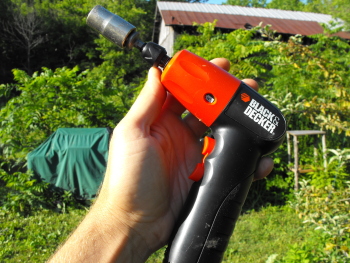 If you've got a low impact, repetitive turning
task that needs to be motorized then the new Black
and Decker 6 volt drill/driver might be just the tool for the job.
If you've got a low impact, repetitive turning
task that needs to be motorized then the new Black
and Decker 6 volt drill/driver might be just the tool for the job.
I've had mine for a couple of weeks now and it's really helped to
streamline our Avian
Aqua Miser building process.
It takes 4 AA batteries and transforms the combined 6 volts of DC power
into a surprising amount of torque. We found this one at a big box
store for just over 10 bucks. Don't expect it to do any medium or heavy drilling chores and you won't be disappointed.
 Joey posted about social capital
yesterday, and the idea really caught my imagination. Last year,
we sold our excess eggs and produce, but this year we've taken to
giving them away. They seem to bring us more value in the latter
situation since folks who are gifted with eggs think more highly of us
and end up doing us favors in return.
Joey posted about social capital
yesterday, and the idea really caught my imagination. Last year,
we sold our excess eggs and produce, but this year we've taken to
giving them away. They seem to bring us more value in the latter
situation since folks who are gifted with eggs think more highly of us
and end up doing us favors in return.
Social capital isn't the
same as bartering --- we don't give folks eggs and expect to get
anything back right away (or even ever.) Instead, we just give
the eggs to people who can use them, mostly to empty out the
fridge. The social capital we garner is just an added benefit.
This
boingboing article and the ensuing discussion raise the intriguing point
that social capital is probably the most widespread economic system in
the world. I think the near-absence of a social capital system in
modern America is part of what we're missing when we complain about the
lack of community in our lives. So, build up your social capital
and reap the rewards!
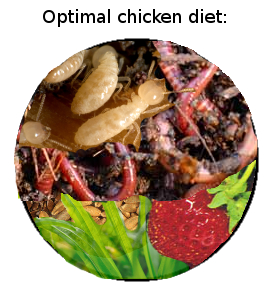 How
can a backyard chicken keeper provide her chickens with the most
nutritious and cheap feed? First of all, let me admit that we
still feed our chickens on laying pellets from the feed store.
But we do supplement our feed with other things and are trying to move
toward minimizing the amount of storebought feed we use.
How
can a backyard chicken keeper provide her chickens with the most
nutritious and cheap feed? First of all, let me admit that we
still feed our chickens on laying pellets from the feed store.
But we do supplement our feed with other things and are trying to move
toward minimizing the amount of storebought feed we use.
Storebought chicken feed
is made up of grains and soybeans, but Jungle
Fowl (the
ancestor of the chicken) feed primarily on
insects.
Scientists who cut open the crops of wild Jungle Fowl found that half
or more of the mashed up food in there was typically insects and other
invertebrates (especially termites.) Various plant matter was
also represented, especially fruits, berries, bamboo seeds, nuts, and
young leaves.
The upshot is clear ---
if we want to wean ourselves off a dependence
on store-bought chicken feed, we shouldn't be planting rows of wheat
and barley. Instead, we need to find ways to provide our chickens
with copious insects. Our chickens eat some insects, both the
ones they find when I move the tractor every morning and the ones I
hand deliver to their enclosures. But several people have
suggested larger scale insect feed operations. Check out some of
these links, for example:
- Fred's Fine Fowl shows you how to trap those Japanese Beetles decimating your roses and feed them to your chickens.
- My idol, Harvey Ussery, breeds both fly maggots and earthworms to feed his chickens.
- Mark has posted before about the option of raising mealworms for your chickens.
I'm a bit leery since you have to grow the mealworms in storebought
materials.
Has anyone given these
ideas a shot? I would really like to come up with a large-scale
method of breeding invertebrates for our chickens to at least take over
the summer feeding.
 This post is part of our Chicken Trivia lunchtime series.
Read all of the entries: This post is part of our Chicken Trivia lunchtime series.
Read all of the entries: |
While you're improving your chickens' health, you should make sure
they have clean water, an easy task with our homemade chicken
waterer.
The experimental
deer contraption let us down the other night due to
the hanger breaking off. We lost a few sweet potato leaves but learned a
valuable lesson.
All future hangers will be at least 14 gauge wire or thicker. The
smaller stuff seems to break after about a week of pivoting. I
shortened the length of tin by about a third, which seems to have
eliminated the possibility of jams. It's still vulnerable to a heavy
wind, which is a factor I'm taking into account for the next generation
of anti-deer, noise making, kinetic, garden sculpture.
| We finally solved the deer in
the garden problem, and the solution was so elegant we gave it a new
website. Check out our deer
deterrent website for free plans! |
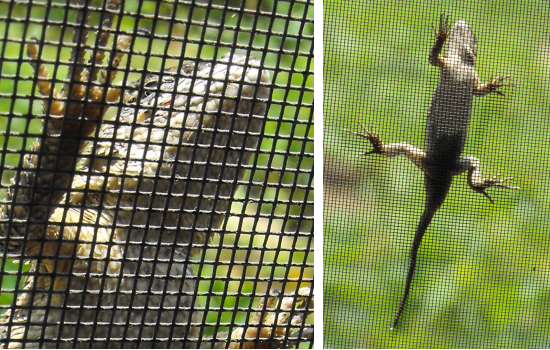
During the summer months, I've taken to working in the garden in the
morning then heading inside for an afternoon in front of the
computer. Sometimes, though, the garden doesn't want to be
ignored.
As I mocked up a client's website on Wednesday, I heard a sudden noise
and looked over to find a Fence Lizard clinging to the window
screen. It seemed to be hunting insects --- perhaps it had
discovered that the window screen acted a bit like a spider's web,
catching flying insects off-guard? Whatever its purpose, the
lizard clung to the screen for nearly an hour before skittering back to
its usual hunting grounds in the garden.
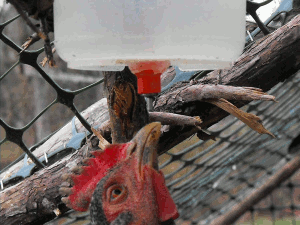 Clean water is essential for chicken health,
but it's easy to overlook for the backyard hobbyist. A
scientific paper in the Proceedings of the Second Mid-Atlantic
Nutrition Conference
notes that chickens who don't drink enough water get sick more easily
and
grow more slowly as chicks. I can't find any hard data, but it
just makes sense that hens would also lay fewer eggs if they had less
to drink.
Clean water is essential for chicken health,
but it's easy to overlook for the backyard hobbyist. A
scientific paper in the Proceedings of the Second Mid-Atlantic
Nutrition Conference
notes that chickens who don't drink enough water get sick more easily
and
grow more slowly as chicks. I can't find any hard data, but it
just makes sense that hens would also lay fewer eggs if they had less
to drink.
But how hard is it to keep plentiful water in your chicken coop?
Not so hard...until you realize that chickens just won't drink if the
water is dirty. With traditional waterers, the water can get
dirty half an hour after you put it out in their coop, or can spill dry
in a tractor in seconds. As we learned during our first summer of
chicken-keeping, the result can be disaster --- two of our hens died of
heat exhaustion due to a spilled waterer on a hot summer day.
Our favorite solution is Mark's chicken waterer invention,
the Avian Aqua Miser.
I feel a bit selfish pointing you all to our store, but the truth is
that I adore our automatic chicken waterers --- they let us go out of
town for four days in the midst of summer without worrying about our
birds! If you don't feel comfortable forking out $15 for a DIY
kit, you should at least keep a careful eye on your chickens' waterers
during the summer months. Before the Avian Aqua Miser, Mark often
gave our girls fresh water multiple times a day. And if you
really want to pamper them, throw some ice cubes into the waterer ---
those chickens will drink as if they're in heaven!
| This post is part of our Chicken Trivia lunchtime series.
Read all of the entries: |
I made our motorized mechanical smasher to streamline a step in the Avian Aqua Miser
building where the wire hanger needs to be squeezed. This way is over
twice as fast compared to using channel locks and saves a ton of wear
on my wrists.
The Skil
7.0 amp drill is a perfect match for this application due to its
adjustable trigger speed and easy to reach reverse switch. Its 1/2
inch heavy duty chuck locks down on the Wilton drill
press vice handle with the right amount of clearance. Watch out!
I'm sure it will smash fingers if given the chance. This is not a toy.

 This week, Mark called our illicit butter
source to see if they had any drugs...er...butter to part with.
This week, Mark called our illicit butter
source to see if they had any drugs...er...butter to part with.
"Sure, I've got three pounds," the neighbor said. "But don't come
over until after 5. I've got to go to the doctor."
When Mark arrived on his doorstep that afternoon, the farmer handed
over the foil-wrapped packages. Mark thanked him and asked how
his appointment had gone.
"Alright, I guess," our neighbor said.
I wasn't there, but I envision a lengthy pause at this point in the
conversation. After all, Mark explained to me that our
butter-source is the salt of the earth and unlikely to complain.
Still, a doctor's appointment can wring a nasty sentence out of the
worst of us.
At last, the farmer gave in. "Yep, the appointment was
alright. But it was cold enough to slaughter a hog in that
waiting room."
 I finished the latest Lee Child novel over
3 weeks ago now and its vivid imagery is still lingering in the
background of my subconscious.
I finished the latest Lee Child novel over
3 weeks ago now and its vivid imagery is still lingering in the
background of my subconscious.
All his books revolve around the Jack Reacher character. A guy who
embraces the drifter lifestyle in such a clever and believable manner
that after you finish one of his adventures you're left with the feeling
of what it might be like to live day to day with only a tooth brush, an
expired passport, and an ATM card.
Gone
Tomorrow takes place in modern day, post patriot act New York City,
which is also the current home of the author. You can feel Child's
affection for the city in his style and pacing throughout the story. I
felt like I needed to be debriefed by Homeland Security after finishing
the book. Its an intense, modern,
narrative that will come close to knocking your socks off with the way its action filled mystery unfolds.
As regular readers know,
I've been putting up my favorite photos on my Imagekind account for
a while. Last week, Imagekind drastically increased the number of
images you can upload with a free account, so I went ahead and uploaded
old
paintings --- my favorite 23 from the last 10 years.
For the three people who missed being able to
see my paintings, there
they are! You can also order notecards and prints off the
website, although they're slightly more expensive than they were when I
made them myself.
In other art-related news, I'm currently working on sketches for a
little mural on the back side of the trailer. I'll post a photo
if it comes to anything.
 The new Skil
drill got a workout the other day when I needed to make a hole
through some cedar posts.
The new Skil
drill got a workout the other day when I needed to make a hole
through some cedar posts.
I was surprised to see just how much more leverage the side handle
gives you.
The 1/2 inch chuck allows for the bigger size bits and the extra 7.0
amp motor provides more than enough power. There's a nice rubber holder
near the handle to hold the chuck key and the speed is adjustable
depending on how hard you squeeze the trigger.
This should make mushroom
log plugging a lot easier when it's not doing duty as our main motorized
mechanical smasher.
 I don't consider myself a competitive person
about things that really matter. But when it comes to the garden,
I'm always racing to get the first spring peas, to eat fresh corn by
the Fourth of July, to harvest the first tomatoes.
I don't consider myself a competitive person
about things that really matter. But when it comes to the garden,
I'm always racing to get the first spring peas, to eat fresh corn by
the Fourth of July, to harvest the first tomatoes.
When we drive to town, I crane my neck to pick out details in the
gardens we pass by. Are their cabbages bigger than my
cabbages? Strangely enough, Mark doesn't let me drive much any
more....
So you can imagine my angst when folks started telling me they were
eating fresh tomatoes. Two weeks ago, reports came in from my
brother in California, but now even my brother fifty miles down the
road has tomatoes.
Okay, so I admit it --- we don't have ripe tomatoes yet. But we
are eating cucumbers, summer squash, okra, sweet corn, swiss chard,
garlic, basil, parsley, carrots, green beans, broccoli,
wineberries, and blackberries. I may have lost the battle, but
maybe I won the war?
 My day in the sun has finally come --- at
long last, it's cool to be a skinflint. Everyone suddenly wants
to save money, and the simple living magazines are scurrying to tell us
all how to be more frugal. I heartily agree with all of their
tips (which I can't seem to find on the internet), but I know that most
folks aren't going to make huge changes in their lives in the interest
of frugality. Instead, this week's lunchtime series offers four
ways to save money without really changing your lifestyle.
My day in the sun has finally come --- at
long last, it's cool to be a skinflint. Everyone suddenly wants
to save money, and the simple living magazines are scurrying to tell us
all how to be more frugal. I heartily agree with all of their
tips (which I can't seem to find on the internet), but I know that most
folks aren't going to make huge changes in their lives in the interest
of frugality. Instead, this week's lunchtime series offers four
ways to save money without really changing your lifestyle.
If you put all four of my tips into practice, you could have an extra
$1,000 (or more) in your pocket every year. Whoa! What will
you do with all that extra cash? If you're doing well, why not
tithe 10% of the excess to a charity you believe in? Here are
some of my favorite charities to get you started:
- The Clinch Coalition
- The Sierra Club
- Appalachian Voices
- Appalachian Community Fund
- National Public Radio
- Population Media Center
Remember --- think
globally, act locally!
| This post is part of our Frugal Living Tips lunchtime series.
Read all of the entries: |

Sometimes a cedar post is just a smidgen too big for even the longest
drill bit we've got. A well placed notch can sometimes solve any problem.
That's what it took today to finish up a trellis for the new grapes.
I struggled with keeping the drill level in the past when boring
through a post. The new Skil
drill has a nifty bubble installed on top to allow for a perfectly
straight angle when drilling horizontally.
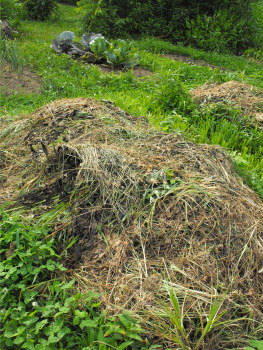 I've been perfecting my raised bed technique
for a while now, and last week I added a new twist. For those of
you who haven't been reading along, I make
wall-less raised beds for my vegetable garden by mounding up topsoil,
then I mow
the aisle between beds as lawn. This method works extremely
well in established garden areas, but requires tilling the first time
the beds are established.
I've been perfecting my raised bed technique
for a while now, and last week I added a new twist. For those of
you who haven't been reading along, I make
wall-less raised beds for my vegetable garden by mounding up topsoil,
then I mow
the aisle between beds as lawn. This method works extremely
well in established garden areas, but requires tilling the first time
the beds are established.
This spring, I made a few new beds without tilling the ground, by piling old asparagus
and and flower stalks on some paper and then adding a little topsoil.
This method worked well too, especially since a few of the asparagus
seeds came up and started to grow.
My newest experiment,
shown here, is meant to increase the height of some established
raised beds without disturbing the grassy aisles. I tossed
several wheelbarrow loads of seedless weeds onto beds which were
currently bare, to be replanted with peas in a month. I'm hoping
this will be a no-till version of a cover crop --- I love the idea of
cover crops, but don't like the necessity to till the plants into the
soil.
The question is whether the weeds will die down into a nice mulch so
quickly. I suspect they will since I made several raised beds
this way a couple of months ago, planted comfrey into them a week or
two later, and watched the comfrey take off. In a worst case
scenario, I can always remove the dead weeds when I plant the peas.
 To be completely honest, I started cutting
Mark's hair because I went with him to his hair appointment and didn't
like seeing strange women running their fingers through his hair.
Unfortunately, short-haired folks like Mark need their hair cut every
couple of weeks or they start looking shaggy.
To be completely honest, I started cutting
Mark's hair because I went with him to his hair appointment and didn't
like seeing strange women running their fingers through his hair.
Unfortunately, short-haired folks like Mark need their hair cut every
couple of weeks or they start looking shaggy.
But a trip to the big city every two weeks to shell out $20 and watch
that jealously guarded head become public property was too much for me
to bear. So, instead, I trotted down to Rite-Aid and bought an electric
razor like this one for less than the cost of one haircut. It
comes with attachments which cut hair at several different lengths,
making it pretty simple to keep Mark looking movie-star perfect on the
farm. (Just be sure to keep the blade oiled.) I figure
we've seen about a 2,000% return on our investment so far --- pretty
good!
| This post is part of our Frugal Living Tips lunchtime series.
Read all of the entries: |

After several rounds of adjustments the latest incarnation of mechanical deer
repellant is working without fail.
Now that it's working I think I'll try my hand at dressing it up a bit
to see if we can't make it look less trashy.
| We finally solved the deer in
the garden problem, and the solution was so elegant we gave it a new
website. Check out our deer
deterrent website for free plans! |
 Tuesday,
Mark and I spent a bit of time working on the forest garden that we
haven't previously talked much about. Unlike the
forest garden we've blogged about extensively,
we're building this one the way Amazonian people have built forest
gardens for hundreds (thousands?) of years --- by encouraging the trees
we find the most useful in an existing forest. This type of
forest garden is most appropriate for big nut trees and other species
which would naturally grow in a mature forest, rather than for the
early successional fruit trees like apples and peaches which need
constant sunlight.
Tuesday,
Mark and I spent a bit of time working on the forest garden that we
haven't previously talked much about. Unlike the
forest garden we've blogged about extensively,
we're building this one the way Amazonian people have built forest
gardens for hundreds (thousands?) of years --- by encouraging the trees
we find the most useful in an existing forest. This type of
forest garden is most appropriate for big nut trees and other species
which would naturally grow in a mature forest, rather than for the
early successional fruit trees like apples and peaches which need
constant sunlight.
The area we chose for
this forest garden is full of young trees which have been growing back
from pasture for just a few decades. Some older trees within the
stand are keepers regardless of their use because I adore old trees,
but most of the forest there is made up of black locust, box-elder,
sassafras, ironwood, dogwood, sourwood, and other small trees. We
added in young seedlings of butternut, persimmon, and Chinese chestnut,
all of which are native or (in the case of the chestnut) replace a
native species wiped out by disease. We also earmarked
some existing trees --- primarily sourwood and black locust --- as
keepers due to their utility as nectar trees for our honeybees.
This forest garden gets
minimal maintenance consisting of rooting out invasives and encouraging
the trees we like. On Tuesday, we cut down a few small trees
around each of our favored trees, mimicking natural treefall gaps and
give our favorites extra light. Or, to be more accurate, Mark cut
down small trees while I stood around and pointed.
 I heartily believe that about 85% of Americans
shouldn't have credit cards. If you've ever paid a fee on your
credit card, it's costing you money. If you've ever used a credit
card to pay for an "emergency expense" you should cut it up now.
If you don't obsessively comb over your credit card bill every month to
check every charge, dispute any problem, then pay your bill in full,
you might as well stick with cash. Of course, if you mind having
all of your intimate purchasing details in the hands of a big company,
you should skip this tip too.
I heartily believe that about 85% of Americans
shouldn't have credit cards. If you've ever paid a fee on your
credit card, it's costing you money. If you've ever used a credit
card to pay for an "emergency expense" you should cut it up now.
If you don't obsessively comb over your credit card bill every month to
check every charge, dispute any problem, then pay your bill in full,
you might as well stick with cash. Of course, if you mind having
all of your intimate purchasing details in the hands of a big company,
you should skip this tip too.
But, for the other 15% of you, sign up for a Discover card and start
raking in the cash. Discover has a cashback program which gives
you 1% to 5% of your purchases back as just plain cash. Don't
fall for their affiliate program where you can turn your cashback into
purchases at your favorite stores --- those are impulse buys and you
don't need that stuff.
To make a Discover card work for you, I believe you should have 3 to 6
months of emergency money stashed away in a savings account.
That's the money you spend if something drastic and terrible happens,
rather than pulling out your Discover card.
That said, use your Discover card for every other possible purchase. We keep our expenses
very low, but still end up getting nearly $200 of free money every year.
If you're keeping track at home, that's an infinite return on our
investment since we didn't spend any extra money to get it.
| This post is part of our Frugal Living Tips lunchtime series.
Read all of the entries: |

Today was a big city errand day. On top of the list was a passport
photo, which finally gave me a chance to try out the Simpsonizeme website. I've tried
the procedure in the past and it always denied my photo. Today Anna
heard me grumbling at the computer and noticed that the site didn't seem to take enough time to scan my picture. She suggested trying
it on the clunky Windows Vista side of the computer instead of the free
wheeling Linux version I use most of the time.
Lo and behold that was the problem. A few minutes later it was done,
but they seem to be stingy with giving you the complete download. They
want you to email it to a friend and then they have to click on a link
to view it. Maybe a select few will be chosen to form a spin-off show
about a group of folks from the neighboring town of Shelbyville?
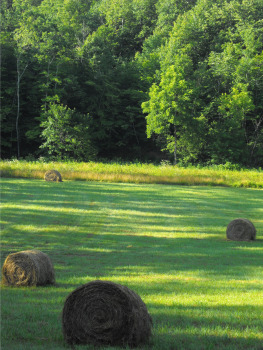 Lucy has found a rotting opossum and dragged
it halfway home, dripping entrails and one-still discernable leg.
I pull my t-shirt up to cover my nose and hurry past, dodging piles of
offal.
Lucy has found a rotting opossum and dragged
it halfway home, dripping entrails and one-still discernable leg.
I pull my t-shirt up to cover my nose and hurry past, dodging piles of
offal.
Past the unlimited green trees of our driveway, we reach the neighbor's
hay field. Lucy and I stop and gaze at new round bales forming a
barricade along the property line. Last hunting season, bright
yellow "No Trespassing" signs sprang up here overnight, fraught with
border tension. But this wet summer's plentiful bales feel like a
protective bulwark.
Back at home, I nearly delete an email from another neighbor.
"Meet Mr. Lucky!" it proclaims, and my fingers think the words are spam
before I decipher the sender's name. Do we want his spare rooster
for our girls? No, our white cochin has dropped her broodiness and
reentered the world of scratching and pecking. But thanks for
asking!
Neighbors and the food chain --- each is colored by our own
perception. Life on the farm is what we make of it.
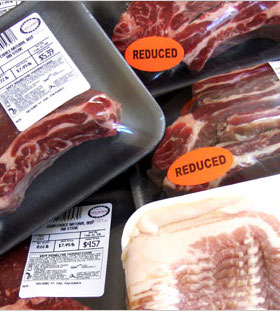 Before Mark came along, I
was nearly a vegetarian. But Mark is a carnivore --- if he
doesn't get his red meat at least once a week, he goes stir
crazy. In fact, I've found that farm work goes a lot faster if I
feed him meat at least every other day.
Before Mark came along, I
was nearly a vegetarian. But Mark is a carnivore --- if he
doesn't get his red meat at least once a week, he goes stir
crazy. In fact, I've found that farm work goes a lot faster if I
feed him meat at least every other day.
So, how do you put a chicken in every pot during a recession?
Head to your grocery store and check out the reduced meat
section. If you get there soon after a batch of meat has been
marked down, you can bring home quite a haul for as low as a dollar a
pound. Toss it all in the freezer immediately and you can thaw it
out at your leisure for the rest of the week. It is perfectly
safe to eat reduced meat as long as you don't let it sit around in your
fridge for another few days first.
Finding reduced meat can turn your grocery store schlep into a fun
adventure. We've discovered that reduced meat is most copious
around holidays like the Fourth of July and Thanksgiving, but you can
also talk to the guy behind the meat counter and find out when he's
likely to mark meat down. I estimate that we save about $200 to
$300 on meat every year by catching bargains.
| This post is part of our Frugal Living Tips lunchtime series.
Read all of the entries: |

These small turnbuckles pack a lot of punch for just 2 dollars.
It's just the thing for getting a grape trellis post nice and taut.
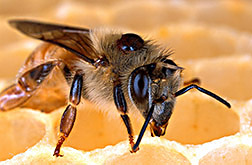 Remember how we're experimenting with
foundationless frames to control varroa mites in our honeybee
hives? Traditional beekeepers put chemicals in the hive every
fall to control the mites, but even the chemicals seem to be failing.
Remember how we're experimenting with
foundationless frames to control varroa mites in our honeybee
hives? Traditional beekeepers put chemicals in the hive every
fall to control the mites, but even the chemicals seem to be failing.
The USDA Agricultural Research Service has discovered what may become a
solution to the varroa mite problem. Since varroa mites find
their hosts by smell, the scientists impregnated sticky paper with bee
odors. 35 to 50% of mites in a hive with this sticky paper let
go of their host bees and head to the paper, where the mites get stuck
and die. The product is still in the testing stages, though so
far the honeybees seem unconcerned by the impregnated paper.
To read more about the study, check out this
quick summary in Scientific American or this
longer version on the ARS's website.
I'm simplifying here. The "smells" are not necessarily smells
--- they might be more like pheremones. The scientists call them
semiochemicals, which just means a chemical that carries a message.
| Read other posts about foundationless frames and varroa mites: |
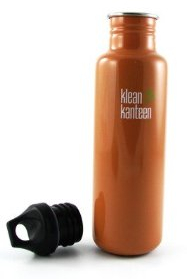 Staying hydrated is good for you, and the
more water you drink the better you'll feel. However, your wallet
will feel much better if you break any dependence you currently have on
bottled water. Sure, it's easy to pick up a bottle from the
vending machine at work, but did you know that if you traded tap water
for a single purchased bottle of water per day, you'd save nearly $550
per year? (Figure out the exact financial and
environmental costs of bottled water here.) Just buy two
reusable water bottles (we've moved to metal for health reasons and
because the water inside tastes much better) and you're all set for a
1,500% return on your investment in the first year.
Staying hydrated is good for you, and the
more water you drink the better you'll feel. However, your wallet
will feel much better if you break any dependence you currently have on
bottled water. Sure, it's easy to pick up a bottle from the
vending machine at work, but did you know that if you traded tap water
for a single purchased bottle of water per day, you'd save nearly $550
per year? (Figure out the exact financial and
environmental costs of bottled water here.) Just buy two
reusable water bottles (we've moved to metal for health reasons and
because the water inside tastes much better) and you're all set for a
1,500% return on your investment in the first year.
But maybe you're not a water drinker. Perhaps you imbibe soda at
the national average of 557 cans per year, which can cost you anywhere
from $200 if you buy it at the grocery store to $600 if you buy it out
of a vending machine. Instead, why not make your own sweet
tea? (That's southern-speak for sweetened iced tea.) Mark
likes his drinks sweet and copious, and I like to keep him off
caffeine, so we pay top dollar for decaffeinated tea bags in the
grocery store --- about $150 per year for his half gallon a day.
If you don't mind caffeinated tea bags, you will probably be paying
half that, all while saving your body from the evils of high fructose
corn syrup and scary additives.
| This post is part of our Frugal Living Tips lunchtime series.
Read all of the entries: |
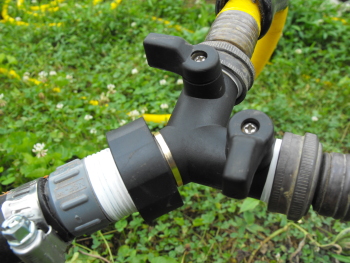 We installed a new Y splitter to create an
additional sprinkler zone for the garden.
We installed a new Y splitter to create an
additional sprinkler zone for the garden.
It's made of metal with plastic coating. We started out using one made
entirely of plastic, which was a mistake I won't repeat again.
The plastic version sometimes leaked and eventually cracked.
The goal is to have the irrigation system down to just turning a valve
off and another one on to switch zones. This way we can save more time
for weeding and other wonderful activities on the farm.
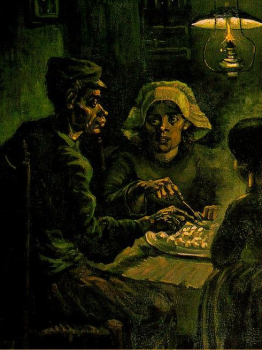 Our tomatoes seem unconcerned by the extra
rains last month, but our potatoes went kaput. That's right, the crop I told
you needed nearly no care.... Sigh.
Our tomatoes seem unconcerned by the extra
rains last month, but our potatoes went kaput. That's right, the crop I told
you needed nearly no care.... Sigh.
My best guess is that they died from Verticillium
wilt or maybe early blight,
or one of the many other diseases caused by fungi and exacerbated by
wet growing conditions. Basically, the potatoes just died back
earlier than expected, leaving behind puny tubers.
Every year, there are a few failures in the garden, and I'm honestly a
bit relieved that this year's biggest failure is the potatoes.
We're once a week potato eaters, and I'd gladly trade the tubers for
the deliciously sweet cucumbers we've been eating (the first year
they've survived our cucurbit-unfriendly garden!)
Still, I like to learn from my mistakes, and I did discover a major one
while researching potato diseases. When I dug our potatoes last
year, I accidentally missed a few which sat in the ground all winter
and started to grow this spring. This is very bad practice with
potatoes since some diseases overwinter in the tubers. So ---
shun the fault I fell in!
It occurred to me last night when the sheet of tin fell off the first
anti-deer contraption due to excessive wear. It was all backwards.
I'm using a golf ball with a wood screw threaded through the middle
suspended by some 14 gauge brace wire. That functions as the new banger,
and now the tin is what it crashes into.
Now we get the initial clang followed by a rubbing sound. The tin has a
small indentation that holds the golf ball every 5th hit or so for just
a few seconds, giving us that random effect that will be more effective
in sounding unnatural and dangerous to the deer.
| We finally solved the deer in
the garden problem, and the solution was so elegant we gave it a new
website. Check out our deer
deterrent website for free plans! |
Mark
spent years --- literally --- teaching me to take weekends off.
I'm finally starting to appreciate them as two days to dream, relax,
visit, overdose on books, and allow myself time to compulsively follow
whims. This weekend, my compulsive whims are twofold.
 I've
gotten a bee in my bonnet that I want to be able to speak a bit of
Spanish when we go to Mexico on our cruise this fall. I know its
silly since we'll only have two days on shore and will be in touristy
areas where everyone will probably speak English. But I always
used to dream that I'd be fluent in half a dozen languages, and was
sorely disappointed when four years of high school Spanish didn't even
make me fluent in one. So I checked out Spanish
in 30 Days (book and CD)
from the library and have been enjoying lots of short, concentrated
bouts of studying ever since. My listening comprehension skills
are horrible, which means it's a fun challenge.
I've
gotten a bee in my bonnet that I want to be able to speak a bit of
Spanish when we go to Mexico on our cruise this fall. I know its
silly since we'll only have two days on shore and will be in touristy
areas where everyone will probably speak English. But I always
used to dream that I'd be fluent in half a dozen languages, and was
sorely disappointed when four years of high school Spanish didn't even
make me fluent in one. So I checked out Spanish
in 30 Days (book and CD)
from the library and have been enjoying lots of short, concentrated
bouts of studying ever since. My listening comprehension skills
are horrible, which means it's a fun challenge.
My other whim is researching how to build simple and cheap sheds.
Mark and I finally decided that we needed to make him a little Avian
Aqua Miser workshop --- he has been constructing our chicken waterers
outdoors under a tarp. On hot days, he's running with
perspiration and is constantly swatting sweat bees. On cloudy
days, he has to scurry and put boxes under cover before they get
soaked. So we're hoping to build a little 8 by 16 foot shed by
winter to enclose his work space and give him more room to
invent. (And maybe give me a little indoor bathing chamber with
lots of windows....) At the moment, it's only a dream, but that's
what weekends are for, right?

The Boing
Boing crew pointed me towards the amazing results achieved by Mike Turner and the new aero
modification of his 1992 Honda Civic.
He's spent around 400 dollars and 250 hours of his time making the car
more aerodynamic. The inspiration came from some of the older designs
from the past that help to streamline air flow while decreasing fuel
intake.
This bit of tinkering has changed his drag coefficient from .34 to .17,
which can equal 90 MPG on a good day!
He claims that hitting a deer with a car like this scoops them up and
over with minimal damage to car and deer. That would make it worth the
400 bucks right there. Watch this 8 second video
if you have any doubts.
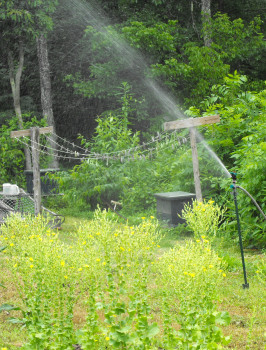 Our
part of the central Appalachian mountains is nearly a temperate
rainforest, with about 40 inches of rainfall scattered evenly
throughout the
average year. Unfortunately, our first two years on the farm
coincided with drought conditions, and I saw firsthand what happens
when plants don't get enough water --- they just stop growing. Berries
are especially sensitive to lack of water, with
experts recommending that they get at least an inch of water per
week.
That's an inch as measured in a rain gauge, which should penetrate to
about 6 to 12 inches into your soil.
Our
part of the central Appalachian mountains is nearly a temperate
rainforest, with about 40 inches of rainfall scattered evenly
throughout the
average year. Unfortunately, our first two years on the farm
coincided with drought conditions, and I saw firsthand what happens
when plants don't get enough water --- they just stop growing. Berries
are especially sensitive to lack of water, with
experts recommending that they get at least an inch of water per
week.
That's an inch as measured in a rain gauge, which should penetrate to
about 6 to 12 inches into your soil.
The drought prompted us to start experimenting with the most cost and
time effective
way to get water to our plants. This week's lunchtime
series runs through our attempts at irrigation --- both the failures
and the successes. Our situation is a bit
unique, so
you should consider your own conditions before putting our suggestions
into practice. Specifically, we are lucky to have copious water
available even during the worst droughts since we have a creek which
runs along the edge of our property --- no need to pay through the nose
for city water and carefully preserve every drop. On the other
hand, the slight turbidity (muddiness) of our creek water makes some
irrigation systems fail which would work well for city-dwellers.
I'd be very curious to hear how my experiences have differed from yours
if you've also embarked on the irrigation journey.
| This post is part of our Irrigation lunchtime series.
Read all of the entries: |
I just found out about a fun new
website last night. (Thanks Maggie) It allows you to build a short
animation complete with your own custom dialog.
That's right. Just type in whatever you can think of and the actors do
their job. You then have some choices to spice it up.
A basic account is free. Anna and I played with it for about 20 minutes
last night and came up with the episode above. A premium account is
only 5 dollars a month.
I've been waiting a long time for technology to make computer animation
easier and more fun. It seems like that day is almost here if places
like xtranormal.com keep up
the good work of bringing esoteric image manipulations down to a cookie
cutter level.
Check out this one by rcg if
you want a good laugh.
The drive to Mark's
ancestral home in Kentucky is short but nerve-wracking. Just
across the Virginia-Kentucky border, the roads go haywire with steep
dropoffs, square feet of pavement missing from important places, and a
complete lack of guard rails. I usually close my eyes and think
of England.
So, when I felt the car slow, I feared the worst --- Mark had spied
oncoming traffic. Gulp. But no menacing headlights
materialized in front of my nervous eyes. Instead, Mark was
peering across the creek at a nicely mown yard complete with trampoline
and free range chickens.
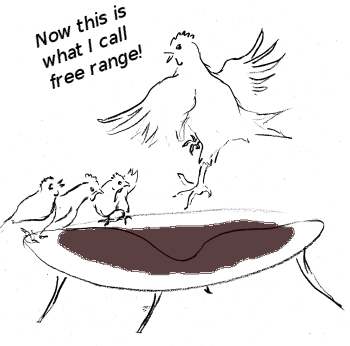
The dozen hens were
perched around the edges of the big trampoline, napping through the
cloudy morning. I didn't have the camera with me, so I've
recreated the scene for your enjoyment. Okay, so the hens weren't
actually jumping on the trampoline in real life, but can you prove to
me that they weren't leaping for joy moments before we drove past?
Although irrigation can
really boost the yield of your garden, watering the wrong way can do
more harm than good. Here are a few problems caused by improper
watering:
- Frequent shallow watering tempts plants to keep all of their roots close to the soil surface. When you forget to water for a few days, your plants shrivel up and die. Instead, you should water deeply (about an inch of water at a time) once a week to promote the growth of deep roots.
- Sprinkler irrigation in the evening can promote the growth of fungi, especially in sensitive plants like tomatoes. For these plants, water first thing in the morning on a sunny day so that their leaves can dry off quickly, or use drip irrigation.
 Rapid watering with a hose can cause soil crust formation in clayey
soils, especially if you tilled your soil too fine or during droughty
conditions. A soil crust forms when tiny soil particles are
washed into the air pores between larger soil particles, forming a
soild mass which prevents further water from soaking into the
soil. To prevent crusting, water clay soil lightly and use
no-till techniques. This
USDA factsheet (from which I got the photo) gives a lot more
information about soil crusting.
Rapid watering with a hose can cause soil crust formation in clayey
soils, especially if you tilled your soil too fine or during droughty
conditions. A soil crust forms when tiny soil particles are
washed into the air pores between larger soil particles, forming a
soild mass which prevents further water from soaking into the
soil. To prevent crusting, water clay soil lightly and use
no-till techniques. This
USDA factsheet (from which I got the photo) gives a lot more
information about soil crusting.
| This post is part of our Irrigation lunchtime series.
Read all of the entries: |
Another deer made it into our perimeter last night, although it was the
section not protected by the 2 noise generators. He even left a pile of
droppings as a not so subtle comment on how he feels about the new
anti-deer contraptions. The garden suffered some serious damage to one
of the best producing beds of strawberries we have.
The short video clip above is the 3rd generation model in action. I
used a small metal fence post for this one because there was no
trellis post to take advantage of in this new location.
| We finally solved the deer in
the garden problem, and the solution was so elegant we gave it a new
website. Check out our deer
deterrent website for free plans! |
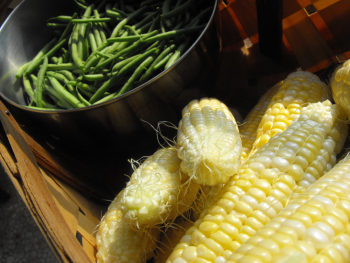 One of the best pieces of gardening advice
I've heard this year is: your very first gardening priority should be
the harvest. It's easy to get caught up in the gardening
locomotive at this time of year and put weeding, mowing, watering, and
planting at the top of your list. But the whole point of the
garden is the food, right?
One of the best pieces of gardening advice
I've heard this year is: your very first gardening priority should be
the harvest. It's easy to get caught up in the gardening
locomotive at this time of year and put weeding, mowing, watering, and
planting at the top of your list. But the whole point of the
garden is the food, right?
Tuesday, we had an all garden dinner --- corn cooked for thirty seconds
in boiling water so that it just turns yellow but there's no time for
the sugars to convert to starch, Masai green beans
sauteed in a little oil with six cloves of garlic, a cucumber and
tomato salad dressed lightly with balsamic vinegar, and fried eggs for
protein. The only parts of our meal which came from elsewhere
were the tomatoes (homegrown by Mark's buddy), and the oil, salt,
pepper, and balsamic vinegar. This is what gardening is all about!
 Most high tech farmers will tell you that
drip irrigation is the best possible method to water your garden.
In some ways they are right --- drip irrigation minimizes your water
usage by putting the water just where your plants need it. You
don't lose water to evaporation and you don't waste water by irrigating
your aisles along with your garden beds. I have seen professional
organic farmers use drip irrigation very effectively, stringing long
pipes under black plastic in raised rows.
Most high tech farmers will tell you that
drip irrigation is the best possible method to water your garden.
In some ways they are right --- drip irrigation minimizes your water
usage by putting the water just where your plants need it. You
don't lose water to evaporation and you don't waste water by irrigating
your aisles along with your garden beds. I have seen professional
organic farmers use drip irrigation very effectively, stringing long
pipes under black plastic in raised rows.
However, for our purposes, drip irrigation failed us. Here's why:
- Drip irrigation depends on
extremely clean water. The tiniest particle of mud sucked
up by our creek pump quickly clogged the holes in our irrigation
system, which meant that the soil around the clogged holes got no
water. If you plan to install drip irrigation with anything
except city water, you will need to install a serious filter and change
it regularly.
- Drip irrigation requires a lot of hoses and they have to be moved every year if you practice crop rotation. Drip hoses with holes two feet apart for watering tomatoes will do that bed no good once you replace the tomatoes with onions spaced three inches apart.
- Drip irrigation is made for row crops, not for beds. I like to maximize space in my permanent raised beds by planting some crops --- carrots, lettuce, greens, etc. --- scattered across the entire surface. Drip irrigation just doesn't work for this setup.
- Drip irrigation is expensive. I'm a skinflint. Enough said.
- To maximize the longevity of those expensive drip hoses, you need to put them under a mulch to prevent UV damage to the plastic. Since most farmers don't have enough organic mulch to cover their entire garden, they usually end up covering the rows with that awful black plastic. Evil, evil, evil!
All of that said, we do
use drip irrigation for our perennial bush fruit. There, we made
the drip hoses ourselves out of 1 inch pipe that a friend was throwing
out, drilling holes much larger than those found in storebought drip
hoses. In permanent plantings, drip irrigation does work wonders.
| This post is part of our Irrigation lunchtime series.
Read all of the entries: |

I learned today not to leave even a little amount of water in the
sprayer after using it. It doesn't take long to get some algae buildup, which will clog the end of the sprayer that reaches the bottom of
the container.
It's pretty easy to clear the clog, which is another selling point for
the MintCraft garden
sprayer I reviewed last month.
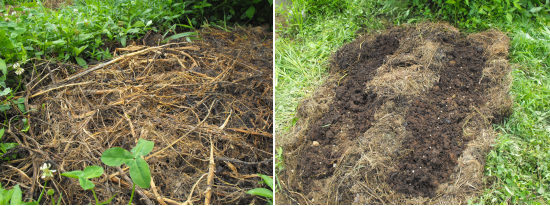
Remember how I piled
up weeds on some fallow beds a few weeks ago? My hope was
that the weeds would rot down into a mulch, killing the weeds on the
bed and protecting the bare soil --- a sort of no-till cover crop.
This week I'm due to plant peas in those beds, so I went to poke at
them. The result --- it's a good technique, but needs a bit of
tweaking. The beds which I covered three weeks ago were nearly
ready to plant into, but I had to pull a lot of weeds on the sides of
the beds, making me think that I should have poured weed mulch there as
well as on the bed tops. I scraped back the mulch with my hands
to open up two rows of bare soil, planted my peas, and sprinkled some
of the mulch lightly over the soil-covered seeds.
Unfortunately, the weeds which I'd dumped on beds a week and a half ago
weren't ready to be planted into yet. I carefully picked through
the weed mulch on one bed to remove any weeds which still showed
color. On another bed, I just gave in and yanked all of the weed
mulch off. I figure in the future, I should plan to leave the
weeds at least a month to rot down before I plant.
Since drip irrigation
didn't work for the majority of our garden, we turned to
sprinklers. We probably spent over a hundred dollars over the
last two summers searching frantically for a sprinkler that fits our
needs. Here's what we discovered about the four major types of
sprinklers:
 Rotary sprinkler --- water gets forced out of
two or three spinning arms, irrigating a circular area. The
problem is that the water outlets are very small and clog easily in
turbid water. When one arm clogs, the sprinkler stops spinning
and just sits there soaking two spots in the garden until you run out
and poke at the clogged arm with a pin, getting soaked in the
process. (Yes, I speak from personal experience.)
Rotary sprinkler --- water gets forced out of
two or three spinning arms, irrigating a circular area. The
problem is that the water outlets are very small and clog easily in
turbid water. When one arm clogs, the sprinkler stops spinning
and just sits there soaking two spots in the garden until you run out
and poke at the clogged arm with a pin, getting soaked in the
process. (Yes, I speak from personal experience.)
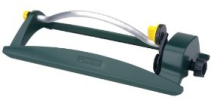 Oscillating sprinkler --- water comes out of
several holes along a metal tube, which moves from side to side so that
a rectangular area is watered. This has the same clogging problem
as the rotary sprinkler, although at least the tube keeps moving when
one hole clogs.
Oscillating sprinkler --- water comes out of
several holes along a metal tube, which moves from side to side so that
a rectangular area is watered. This has the same clogging problem
as the rotary sprinkler, although at least the tube keeps moving when
one hole clogs.
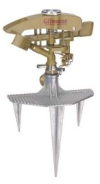 Pulsating sprinkler --- our pride and joy!
Water comes out of a big hole in a steady stream so that the sprinkler
never clogs, then the water is broken up by moving parts into a gentle
mist. You can set the sprinkler to water a full circle or any
type of semicircle and can also set the diameter of the circle as well
as the size of the water droplets. These sprinklers have the
bonus of being able to water areas as large as 100 feet in
diameter. We started with a cheap plastic version, then upgraded
to the metal version shown here, which cost us about $10 per sprinkler
(bought in two-packs at the big box store.)
Pulsating sprinkler --- our pride and joy!
Water comes out of a big hole in a steady stream so that the sprinkler
never clogs, then the water is broken up by moving parts into a gentle
mist. You can set the sprinkler to water a full circle or any
type of semicircle and can also set the diameter of the circle as well
as the size of the water droplets. These sprinklers have the
bonus of being able to water areas as large as 100 feet in
diameter. We started with a cheap plastic version, then upgraded
to the metal version shown here, which cost us about $10 per sprinkler
(bought in two-packs at the big box store.)
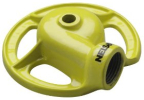 Stationary sprinkler --- this is merely a chunk
of metal with no moving parts, so it's pretty indestructible.
Like the pulsating sprinkler, there is no clogging problem, and the
kind we bought has the major bonus that it will run on low water
pressure. (We had to hook the other three types directly to the big pump
to make them run, but our stationary sprinklers run on gravity
from our thousand gallon tank.) The downside to stationary
sprinklers is that they only water small areas, but I like to use them
to fill in gaps in our irrigation setup, watering solitary beds which
would be wasteful to water with the pulsating sprinkler.
Stationary sprinkler --- this is merely a chunk
of metal with no moving parts, so it's pretty indestructible.
Like the pulsating sprinkler, there is no clogging problem, and the
kind we bought has the major bonus that it will run on low water
pressure. (We had to hook the other three types directly to the big pump
to make them run, but our stationary sprinklers run on gravity
from our thousand gallon tank.) The downside to stationary
sprinklers is that they only water small areas, but I like to use them
to fill in gaps in our irrigation setup, watering solitary beds which
would be wasteful to water with the pulsating sprinkler.
| This post is part of our Irrigation lunchtime series.
Read all of the entries: |
 We upgraded to a second packaging
tape dispenser recently to speed things along in the Avian Aqua Miser
building process.
We upgraded to a second packaging
tape dispenser recently to speed things along in the Avian Aqua Miser
building process.
This one is made by Scotch, and it's considered heavy duty. It was
about 10 bucks, which includes a small roll of tape.
It works better than the cheaper model we bought back in the winter,
and it has a nice feature that hides the cutting blades until one puts
pressure on the top guard.
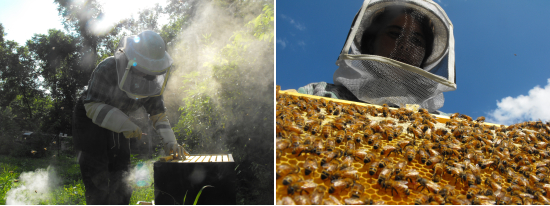
We hadn't dug into our
hives in quite a while, so Thursday we went out to check on the
bees. The last couple of times we checked, the bees had barely
made any progress and hadn't yet started to build on their
supers. This time was different.
The recent
flow of sourwood nectar jumpstarted three of the four hives.
Take a gander at the capped honey on the frame to the left below.
I had been worried that the bees didn't like the foundationless frames
on the supers, but now the brood box frames are totally full on three
hives, and two of those hives had started filling in the frames on the
supers.
One hive, though, is lingering behind. The picture to the right
below is one of the edge frames from the brood box --- still barely
built on. I'm concerned that these girls might not survive the
winter if they don't start working harder. I'll have to do some
research and see if there's any remedy.
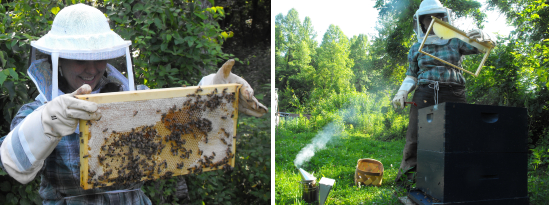
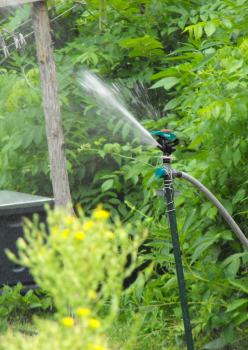 During the 2008 droughty summer, we were low
on both time and money since I was working for pennies at a local
nonprofit. After shelling out so much cash to find a type
of sprinkler that worked for us, we could only afford to get a couple
of them. So I laboriously moved hoses and sprinklers multiple
times a week to reach every zone in the garden, often crushing plants
at the edges of beds in the process.
During the 2008 droughty summer, we were low
on both time and money since I was working for pennies at a local
nonprofit. After shelling out so much cash to find a type
of sprinkler that worked for us, we could only afford to get a couple
of them. So I laboriously moved hoses and sprinklers multiple
times a week to reach every zone in the garden, often crushing plants
at the edges of beds in the process.
This year, we're working
on a more permanent setup. The upfront cost has been about $80,
since we splurged on several more sprinklers, but we've nearly gotten
to the point where we can water the entire garden just by flicking a
switch and then a series of valves. Our permanent system consists
of pulsating sprinklers on three foot tall fenceposts at the edges of
the garden --- the height allows water to spray over tall beds of
tomatoes to reach shorter plants in the background. We turn on
two sprinklers at a time, since adding any more sprinklers to the
system drains the water pressure.
 We're still tweaking the
system to achieve the head to head coverage recommended by sprinkler
experts. We'll keep you posted about anything we figure out as we
optimize this stage.
We're still tweaking the
system to achieve the head to head coverage recommended by sprinkler
experts. We'll keep you posted about anything we figure out as we
optimize this stage.
| This post is part of our Irrigation lunchtime series.
Read all of the entries: |
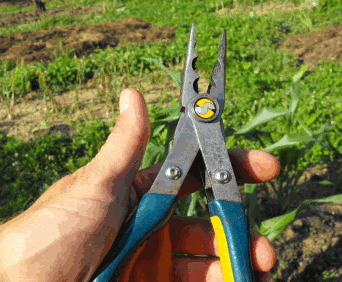 I forget the name for these flip pliers. I
bought them during a stage of my life when I was doing industrial
fencing...that's chain link fence...not fancy sword fighting for some
corporate pirate outfit.
I forget the name for these flip pliers. I
bought them during a stage of my life when I was doing industrial
fencing...that's chain link fence...not fancy sword fighting for some
corporate pirate outfit.
Some days I would spend hour after hour securing long lines of chain
link fence to its respective post. These pliers were good for that, but
not optimal. They mainly functioned as a back up to my heavier duty
set.
I thought this particular tool was gone forever in that vast vacuum of
nothingness that tools disappear to. It showed up earlier this week
when we were helping my mom with some home repair jobs. Somehow it got
mixed in with her tools and she was happy to match it back up with its
previous owner. Thanks Mom!
What I really like it for is the help it provides while I put together
the hanger portion of what I think is the best chicken waterer money
can buy. I used to use needle nose pliers, and then channel locks
to finish each hanger. Now I just give these flip pliers a West Side
Story switchblade twist and I'm switching tools without setting one
down.
I think this tool is on par with the Trake...yes,
it's that good.
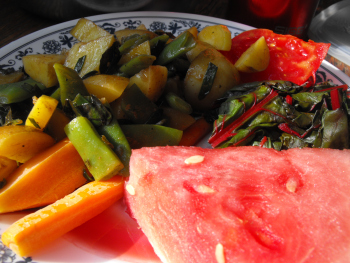 Mark
has been quashing his carnivorous urges and we've been eating a lot of
all vegetable dinners this week. Last night I made a Green Bean and
Potato Salad which
was remarkably delicious!
Mark
has been quashing his carnivorous urges and we've been eating a lot of
all vegetable dinners this week. Last night I made a Green Bean and
Potato Salad which
was remarkably delicious!
We used Mark's mom's
Roma Beans, which we rate 7/10 for taste (compared
to Masai which we rate 10/10) and our poor, blighted potatoes. I
can't wait to see how much better the salad will be with our beloved
Masai Beans!
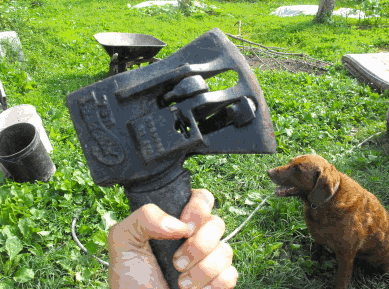 We found a Chopper1 axe at a yard sale
today for just 10 bucks.
We found a Chopper1 axe at a yard sale
today for just 10 bucks.
Bob Kolonia invented it back in 1975. What makes it unique is the
rotating levers on each side of the axe's head. The levers swing out,
directing the downward chopping force outward and exploding the log
apart from the inside. His website has a nice animation that
explains the process better. Ours is missing one of the return springs
and pin that holds the spring. I'm sure I can rig something up before
winter sets in. Stay tuned to see how well this baby chops wood
compared to our Super
Splitter.
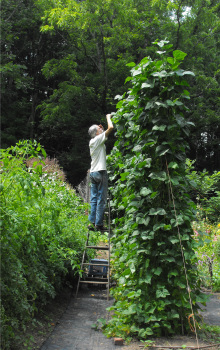 One day when I was a kid, my parents dragged
me along to a garden party. I was even more antisocial then than
I am now, so I disappeared off into the plants for the afternoon.
The garden was a wonder of flowers, fruit, and vegetables, many I'd
never seen before. When no one was looking, I nibbled on the
first currant I'd ever tasted. Somewhere between the broccoli and
the strawberries, I imprinted on that garden just like a baby chicken
can imprint on its human handlers.
One day when I was a kid, my parents dragged
me along to a garden party. I was even more antisocial then than
I am now, so I disappeared off into the plants for the afternoon.
The garden was a wonder of flowers, fruit, and vegetables, many I'd
never seen before. When no one was looking, I nibbled on the
first currant I'd ever tasted. Somewhere between the broccoli and
the strawberries, I imprinted on that garden just like a baby chicken
can imprint on its human handlers.
Fast forward a decade or
two into the future, and I met the owners of the garden for the first
time in my adult life. The husband had become my co-worker at the
nonprofit, and I was awed when I went over to his house and saw the
garden which I vividly recalled from childhood. The wife is the
main garden tender, and she soon became my garden guru.
Saturday, we went over
to visit them and their garden. As usual, I was stunned by the
results of thirty years of organic soil amendments. Their corn
was literally twice as tall as my corn. And, as you can see in
this photo, they pick their beans with a full size ladder!
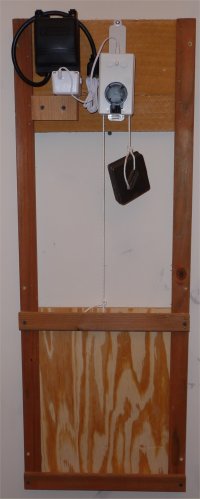 ChickenCoopDoor.com
takes the guess work out of building your own automatic chicken coop
door opener with its complete kit for 150 dollars.
ChickenCoopDoor.com
takes the guess work out of building your own automatic chicken coop
door opener with its complete kit for 150 dollars.
Could you build something cheaper that does the same thing? Maybe...
depending on your skill level and access to tools and supplies...and
then there's the time issue. I think we all can imagine a project like
this taking more hours than anticipated to get it just right.
Chances are if you are in need of such a device you want it right away
before some hungry raccoon decides to make a midnight snack out of your
best laying hen.
It seems like it would be worth the money, time, and emotional anguish
to splurge for the door if you prevent even one attack from happening.
Of course another solution is to abandon the coop concept and make your
birds a chicken
tractor, but I know that's just not possible for some folks.
While you're simplifying your chicken care lives, you might check out our homemade
chicken waterer.
Edited to add:
After years of research, Mark eventually settled on this automatic chicken door.
You can see
a summary of the best
chicken door alternatives and why he chose this version here.
If you're planning on
automating your coop, don't forget to pick up one of our chicken waterers. They never spill or
fill with poop, and if done right, can only need filling every few days
or weeks!
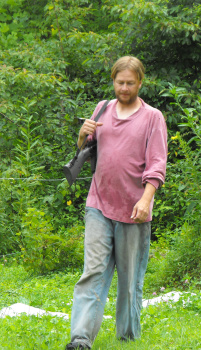 "Mark,
get the gun!" I shrieked.
"Mark,
get the gun!" I shrieked.
Did those words really come out of my pacifist, animal-loving
mouth? But there she stood --- a beautiful doe --- between the
sweet corn and the sweet potatoes. It was broad daylight, so our deer
deterrants were turned off, and Lucy was snuggled up in her dog
house to avoid the drizzle.
By the time the words left my mouth, the deer was gone, leaping through
tall weeds back into the woods. Mark shot after her anyway.
"And stay out!" the rifle retorts seemed to be saying.
Maybe we need to leave the "clankers" (as I've been known to call them)
on during the day?
| We finally solved the deer in
the garden problem, and the solution was so elegant we gave it a new
website. Check out our deer
deterrent website for free plans! |
 Mark and I enjoy reviewing interesting
products, books, and other things which pass through our lives. A
lot of them seem really cool at the time, then fade into
obscurity. Others become integral parts of our lives.
Mark and I enjoy reviewing interesting
products, books, and other things which pass through our lives. A
lot of them seem really cool at the time, then fade into
obscurity. Others become integral parts of our lives.
Like a love affair, what counts isn't the first flush of lust, but the
lasting joy of togetherness. This week's lunchtime series
revisits some of the top products we've reviewed over the last ten
months to see which ones have sticking power.
| This post is part of our Re-Reviews lunchtime series.
Read all of the entries: |
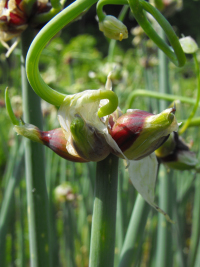 Our
Egyptian onions made a lot more top bulbs this summer than I'd
expected. I've given them to every family member who will take
them, shipped them out with our automatic chicken waterers, and mailed some to my loyal
readers. But we still have a few hundred top bulbs left, and I'd
like them to go in the ground soon.
Our
Egyptian onions made a lot more top bulbs this summer than I'd
expected. I've given them to every family member who will take
them, shipped them out with our automatic chicken waterers, and mailed some to my loyal
readers. But we still have a few hundred top bulbs left, and I'd
like them to go in the ground soon.
So it's time for
Egyptian onion giveaway number 3! This time, I'm going to mail
out a lot of bulbs --- maybe a hundred or more, depending on what's
left in the box. To enter the
giveaway, just leave a comment on any post by August 3. I'll
throw your name in the hat (multiple times if you make multiple
comments)
then will contact the winner through the blog. (Be sure
to check back on August 4 to see if you won!) That way you
have an incentive to leave us lots of comments. I look
forward to hearing from you!
For those of you
unfamiliar with Egyptian onions, these are some of my
favorite garden plants. The onions are perennials, and while you
can eat the small bulbs most people grow them for the greens --- my CSA
customers unanimously told me that even people who don't like green
onions like these greens. Read more about our
Egyptian Onions (and how you can get some free by
ordering 3 Avian Aqua Misers) here.
 The most unexpected perk I've run into
with our chicken waterer
microbusiness is the strangers I meet who turn out to be both kind and
fun. Author and blogger Julie A. Carda posted a delightful story
of her
chickens' introduction to the Avian Aqua Miser yesterday, making me
grin from ear to ear.
The most unexpected perk I've run into
with our chicken waterer
microbusiness is the strangers I meet who turn out to be both kind and
fun. Author and blogger Julie A. Carda posted a delightful story
of her
chickens' introduction to the Avian Aqua Miser yesterday, making me
grin from ear to ear.
The story was just the kind of flight of fancy I adore reading, so I
wasn't surprised to find that Julie has written two books full of
intrigue, romance, espionage, and the paranormal.
You can buy the first one either as an ebook or a paperback. Or
just download the second book for free. (Once you decide you love
it, you can head back to her site and leave a donation.)
Thanks for the story, Julie!
Podcasts,
games, magazines, movies, and websites:
 Agroinnovations
podcast - Mark's
still listening regularly and enjoys their high quality archives.
Agroinnovations
podcast - Mark's
still listening regularly and enjoys their high quality archives.
 Carcassone: The
Discovery - I still
adore this game, probably because I've only gotten to play it a half
dozen times when Joey and I get together.
Carcassone: The
Discovery - I still
adore this game, probably because I've only gotten to play it a half
dozen times when Joey and I get together.
 Star Trek - still one of the best
movies we've seen all year. I suspect we'll watch it again a time
or two once it comes out on DVD.
Star Trek - still one of the best
movies we've seen all year. I suspect we'll watch it again a time
or two once it comes out on DVD.
 C-realm
podcast - Mark
still listens to it every week when it comes out.
C-realm
podcast - Mark
still listens to it every week when it comes out.
 The Field
Lab
- He gets four stars just for showing up every day. The
information can be a bit repetitive, but Mark keeps going back for
more, watching the day by day unfolding of an American dream.
The Field
Lab
- He gets four stars just for showing up every day. The
information can be a bit repetitive, but Mark keeps going back for
more, watching the day by day unfolding of an American dream.
 Yoga videos -
the winter retreated and yoga fled with it. I may go back to
these videos
when the cold weather returns, but we'll have to wait and see.
Yoga videos -
the winter retreated and yoga fled with it. I may go back to
these videos
when the cold weather returns, but we'll have to wait and see.
 Countryside Magazine - seemed like a good
magazine, but I only have room for so many magazines in my life, so I
stopped reading.
Countryside Magazine - seemed like a good
magazine, but I only have room for so many magazines in my life, so I
stopped reading.
 Royalty free
music - Mark
thought this was cool, until he realized that it was far from
free. The music was vastly overpriced, and he won't be going back.
Royalty free
music - Mark
thought this was cool, until he realized that it was far from
free. The music was vastly overpriced, and he won't be going back.
| This post is part of our Re-Reviews lunchtime series.
Read all of the entries: |
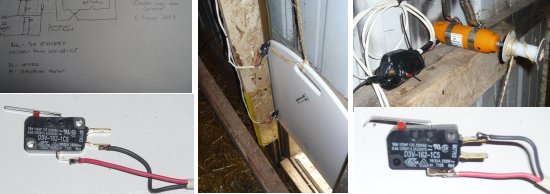
I like Chris and
Keri's automatic chicken door solution for several reasons. The design
is simple, solid, and cheap to do for under 20 bucks, and they have
detailed pictures with videos, and a wiring schematic to make the
process easy for someone who might want to follow in this direction.
I've been looking at several different versions of these automatic
doors on the internet and this is one of the first to use limit
switches, which might come in handy for future experiments.
This is a plan I would favor because of the low cost and easy to
follow directions. Thanks for sharing Chris and Keri.

Edited to add:
After years of research, Mark eventually settled on this automatic chicken door.
You can see
a summary of the best
chicken door alternatives and why he chose this version here.
If you're planning on
automating your coop, don't forget to pick up one of our chicken waterers. They never spill or
fill with poop, and if done right, can only need filling every few days
or weeks!
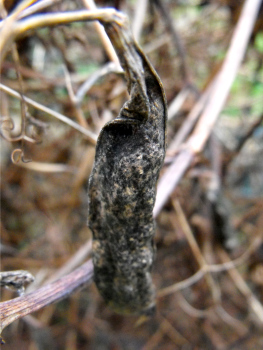 Remember our beautiful snow
peas? Now they don't look quite so beautiful, having died
back into a mass of brown vines. That means the peas are ready
for the second harvest --- saving the seeds!
Remember our beautiful snow
peas? Now they don't look quite so beautiful, having died
back into a mass of brown vines. That means the peas are ready
for the second harvest --- saving the seeds!
I'm hit or miss on my seed-saving, but I do like to save the easy ones
--- peas, beans, and okra. It's hard to go wrong. Just
leave some pods on the plant until they turn brown and dead, shell out
the seeds, and store them in an air tight container. Or, if
you're like me, toss them in an open pint canning jar and forget about
them until next year when they sprout great anyway.
The great thing about saving snow pea seeds is that you don't even have
to set aside a special bed for it. You'll inevitably allow a few
pods to get too woody before you pick them --- just leave those on the
vine and they'll mature nicely. I missed enough snow pea pods to
provide seeds for at least a year.
| Read other posts about saving seeds: |
Home
and shop tools:
 Fuji
Finepix S100fd
- We both still adore this camera. We've yet to use all of its
features, or to reach many limits in its abilities. The only
thing it
doesn't seem to do well is extremely low light conditions without a
flash, but I suspect we just haven't found the proper setting for that
yet.
Fuji
Finepix S100fd
- We both still adore this camera. We've yet to use all of its
features, or to reach many limits in its abilities. The only
thing it
doesn't seem to do well is extremely low light conditions without a
flash, but I suspect we just haven't found the proper setting for that
yet.
 Liquid
nails - I think that
if Mark had to choose between me and a lifetime supply of liquid nails,
it might be a hard choice....
Liquid
nails - I think that
if Mark had to choose between me and a lifetime supply of liquid nails,
it might be a hard choice....
 Palomino
grain cowhide gloves
- Still Mark's all-time favorite gloves.
Palomino
grain cowhide gloves
- Still Mark's all-time favorite gloves.
 Skil saw - This electric saw keeps
right on going. We often bring it with us when we need to do home
repairs away from the farm.
Skil saw - This electric saw keeps
right on going. We often bring it with us when we need to do home
repairs away from the farm.
 Ultimate
sink strainer
- a piece broke off the bottom of one strainer under light wear, but
the lost piece didn't seem to affect the strainer's performance.
A great replacement to the dishrag mashed in the drain with a pint
canning jar.
Ultimate
sink strainer
- a piece broke off the bottom of one strainer under light wear, but
the lost piece didn't seem to affect the strainer's performance.
A great replacement to the dishrag mashed in the drain with a pint
canning jar. 
 pStyle - I thought the pStyle was a
great idea, but I forgot about it after a week. Must have been
the return of warm weather.
pStyle - I thought the pStyle was a
great idea, but I forgot about it after a week. Must have been
the return of warm weather.
Champion
3000 watt generator
- It's sitting in the barn looking pretty. We've yet to have a
serious power outage, so haven't revved it up. We probably should
give it a spin, though, just to see how it works.
| This post is part of our Re-Reviews lunchtime series.
Read all of the entries: |
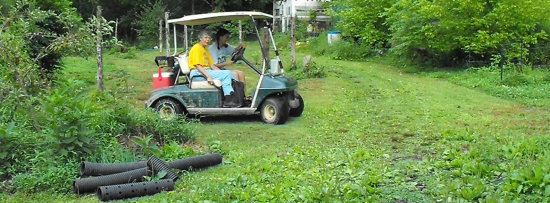
We had another flat on the Club Car golf cart yesterday. It was on the
only wheel without an inner tube. That's 3 separate trips to the tire
guy in the span of a year.
The lesson to learn here is if you're going to use a golf cart under
heavy farm conditions then you might as well install inner tubes in all
4 tires and save yourself some time and energy.
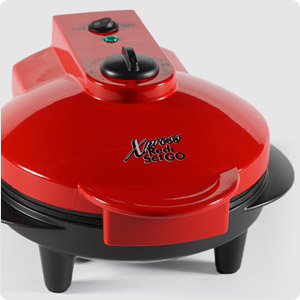 Everett sent us a Redi-Set Go Indoor
Grill to test out last week. While the recipes included were
aimed at the culinary illiterate, the grill itself worked like a
charm. I tested it out on fish patties and banana muffins and was
very impressed by the quick and easy cooking. Both came out
pleasantly browned with a crusty exterior and a moist interior. I
did have to use some oil despite the pans being non-stick. (This
may be par for the course --- I know very little about non-stick
surfaces.)
Everett sent us a Redi-Set Go Indoor
Grill to test out last week. While the recipes included were
aimed at the culinary illiterate, the grill itself worked like a
charm. I tested it out on fish patties and banana muffins and was
very impressed by the quick and easy cooking. Both came out
pleasantly browned with a crusty exterior and a moist interior. I
did have to use some oil despite the pans being non-stick. (This
may be par for the course --- I know very little about non-stick
surfaces.)
I think the grill may fill a nice niche in our cooking lives, fixing
small dishes which only Mark likes (such as the fish patties) or which
I want to whip together quickly in the morning (like the banana
muffins.) What I like the best is that the grill stores on its
end, so it only takes up about three or four inches of counter space.
My biggest warning --- don't open the enclosed recipe book and get
excited by the picture of lava cake muffins. That recipe is not
included. I guess I'll be looking for a good lava cake recipe now
--- anyone?
Garden
and water tools:
 TC1840H
Garden Cart
- I would recommend this cart to anyone. We've ridden it hard and
put it
to bed wet, and still it keeps right on hauling all of our household
and garden supplies.
TC1840H
Garden Cart
- I would recommend this cart to anyone. We've ridden it hard and
put it
to bed wet, and still it keeps right on hauling all of our household
and garden supplies.
 Ridgid 1 HP Sump
Pump - This is our
well pump, and it keeps right on pumping like a dream!
Ridgid 1 HP Sump
Pump - This is our
well pump, and it keeps right on pumping like a dream!
 Thousand gallon tank - Still plugging right
along, making our life easier.
Thousand gallon tank - Still plugging right
along, making our life easier.
 Trake - I'd like to give this tool
six stars, but it would mess up my rating system. The trake makes
weeding a joy!
Trake - I'd like to give this tool
six stars, but it would mess up my rating system. The trake makes
weeding a joy!
 Heavy
hauler
- The heavy hauler continues to hold up under serious abuse. The
only downside is that it's hard to maneuver by hand --- keep it hitched
up to the golf cart or your lawn tractor and you'll be in good shape.
Heavy
hauler
- The heavy hauler continues to hold up under serious abuse. The
only downside is that it's hard to maneuver by hand --- keep it hitched
up to the golf cart or your lawn tractor and you'll be in good shape.
 Mintcraft garden sprayer - A competent gadget for the
price. For under $20, what would you expect?
Mintcraft garden sprayer - A competent gadget for the
price. For under $20, what would you expect?
 Kink-free flex
hose adapter - still
keeping our well hose kink-free many months later.
Kink-free flex
hose adapter - still
keeping our well hose kink-free many months later.
| This post is part of our Re-Reviews lunchtime series.
Read all of the entries: |

A heavy
duty tarp has a million uses on a farm. Don't waste your time or
money on the lower grade tarps that barely last a few months before
they start showing signs of wear.
We put ours to use today on the roof over a trouble spot that insists
on leaking in the middle of our kitchen. With any luck it will stay dry
long enough to finish up the repair tomorrow.
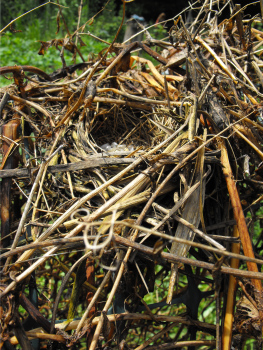 A month ago, a Song Sparrow took up residence
in the snow peas. I saw her flit away every time I went out to
pick peas, but I didn't think any more of it, especially since the
season was almost over and I soon stopped picking.
A month ago, a Song Sparrow took up residence
in the snow peas. I saw her flit away every time I went out to
pick peas, but I didn't think any more of it, especially since the
season was almost over and I soon stopped picking.
Yesterday, though, I went out to harvest
the rest of the seeds. I kept waiting for a dry day, but
finally threw up my hands and harvested in a gentle rain, discarding
the seeds that had sprouted (or molded) in the pod. The seeds are
drying on a tray now --- about a pint of them which I figure means we
have some to spare for a future giveaway!
Anyhow, as I started to rip out the dead vines post-harvest, I was
stunned to see a perfect bird's nest right smack in the middle.
My resident Song Sparrow wasn't just nibbling on insects in the foliage
as I'd suspected, she was raising her young! The nest was empty
now, except for some gnawed on pea seeds. (Perhaps a mouse took
up residence after the birds moved out?) So after snapping some
photos, I tore the nest out to add to the mulch on a dormant bed.
A little toad hopped away while I was working, and I was stunned that
one garden bed could support so much life.
Books:
 Mycelium
Running
- This is still one of the most fascinating books I've read this
year. Although my morel cultivation didn't work out, I'm going to
keep experimenting.
Mycelium
Running
- This is still one of the most fascinating books I've read this
year. Although my morel cultivation didn't work out, I'm going to
keep experimenting.
 Edible
Forest Gardens, volume 2 - I'm still incorporating
this book's information into our gardening lives and I rank it right up
there with Mycelium
Running.
That reminds, I wanted to order the first volume in the set from
interlibrary loan....
Edible
Forest Gardens, volume 2 - I'm still incorporating
this book's information into our gardening lives and I rank it right up
there with Mycelium
Running.
That reminds, I wanted to order the first volume in the set from
interlibrary loan....
 The
Backyard Beekeeper -
I pored over this book for weeks when we started out with our bees, and
I still dip back into it. A keeper.
The
Backyard Beekeeper -
I pored over this book for weeks when we started out with our bees, and
I still dip back into it. A keeper.
 The
4-Hour Work Week
- Some books you love at the time, then forget about. This book
was the opposite. At first, I wasn't so sure that I liked it, but
I kept coming back to its advice as we developed our
microbusiness. Now I'm about due to re-read it.
The
4-Hour Work Week
- Some books you love at the time, then forget about. This book
was the opposite. At first, I wasn't so sure that I liked it, but
I kept coming back to its advice as we developed our
microbusiness. Now I'm about due to re-read it.
 The Good
Life - Bits of this
book keep popping back into my head, though it's not one I'd feel the
need to own.
The Good
Life - Bits of this
book keep popping back into my head, though it's not one I'd feel the
need to own.
 Letters
from the Hive - A
fun book, but I passed it on and didn't miss it.
Letters
from the Hive - A
fun book, but I passed it on and didn't miss it.
 Full Moon Feast - Falls into the Letters
from the Hive
category. A good book to check out of the library.
Full Moon Feast - Falls into the Letters
from the Hive
category. A good book to check out of the library.
 The
Ultimate Cheapskate
- I enjoyed this book at the time, but I honestly can't say I remember
much about it.
The
Ultimate Cheapskate
- I enjoyed this book at the time, but I honestly can't say I remember
much about it.
| This post is part of our Re-Reviews lunchtime series.
Read all of the entries: |
We had another deer invasion last night. Some minor damage to the sweet
potato leaves on the far end of the garden. I'm coming to the conclusion
that these anti-deer
contraptions have an effective range of about 50 feet.
The 4th contraption was built today with a bonus sound. After the tin
smashing sound we now get a thunk or a clink when the golf ball hits
the new steel cup which is the same one Anna took around the world
during her Watson
fellowship.
Maybe now this will cover our entire garden perimeter...time will tell.
| We finally solved the deer in
the garden problem, and the solution was so elegant we gave it a new
website. Check out our deer
deterrent website for free plans! |
Want more in-depth information? Browse through our books.
Or explore more posts by date or by subject.
About us: Anna Hess and Mark Hamilton spent over a decade living self-sufficiently in the mountains of Virginia before moving north to start over from scratch in the foothills of Ohio. They've experimented with permaculture, no-till gardening, trailersteading, home-based microbusinesses and much more, writing about their adventures in both blogs and books.
